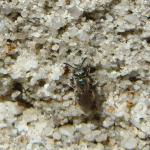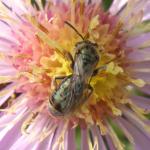One of two large metallic green Lasioglossum bees in Britain. This species has a rather blue-green sheen over both the thorax and abdomen which can often be discerned in the field. Although these features often serve to distinguish it from the similarly green L. morio and L. leucopus, separation from the closely related, but more northerly and westerly distributed, L. cupromicans requires considerable care and microscopic examination.
Restricted to southern England, Channel Islands, Wales and north to Northumberland. It is gradually replaced by the closely related L. cupromicans towards the north, and in upland situations, particularly in the South-west. The species has a generally Mediterranean and Atlantic distribution in Europe. It is also known from north Africa.
This bee is not regarded as being scarce or threatened. However, the species does seem to have declined nationally in recent years (G R Else, pers. comm. & M Edwards, pers. obs.).
Although L. smeathmanellum may be encountered almost anywhere in southern England and Wales, it is often abundant on coastal soft-rock cliffs. Inland it is frequently reported as nesting in the soft mortar of old walls.
Females fly between late March and September, males are found between July and September. As with all British Lasioglossum, only mated females hibernate.
Often nests communally in suitable areas of old walls and bare cliffs, but is not known to be eusocial, with a queen and a few workers.
Recorded visiting a wide variety of flowers from a number of different plant families.
2005



